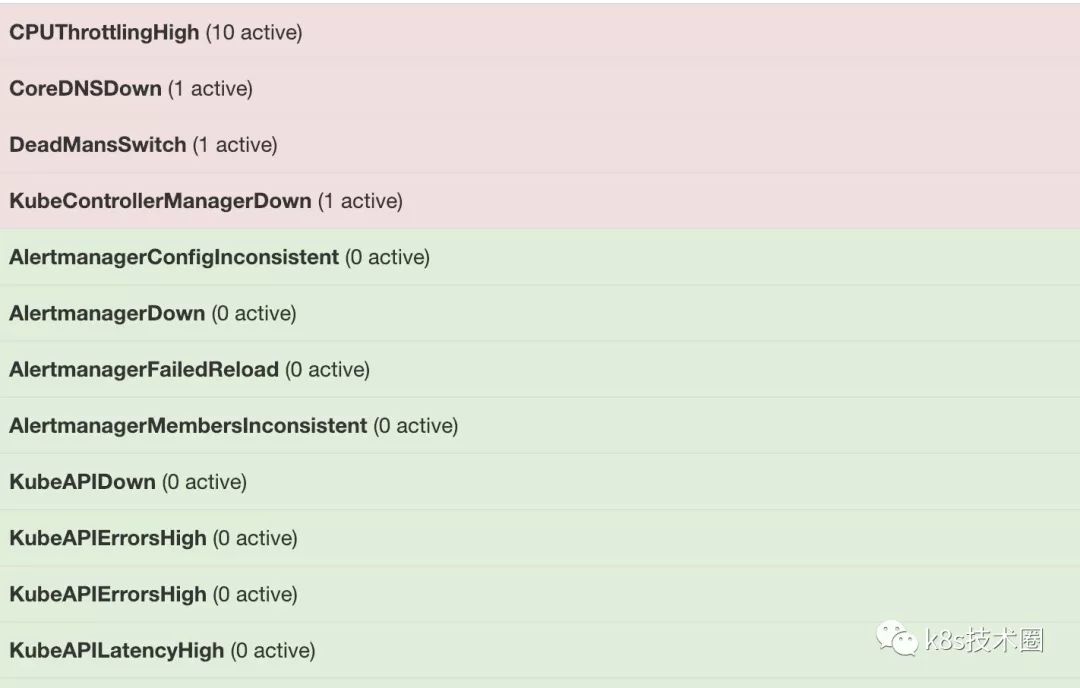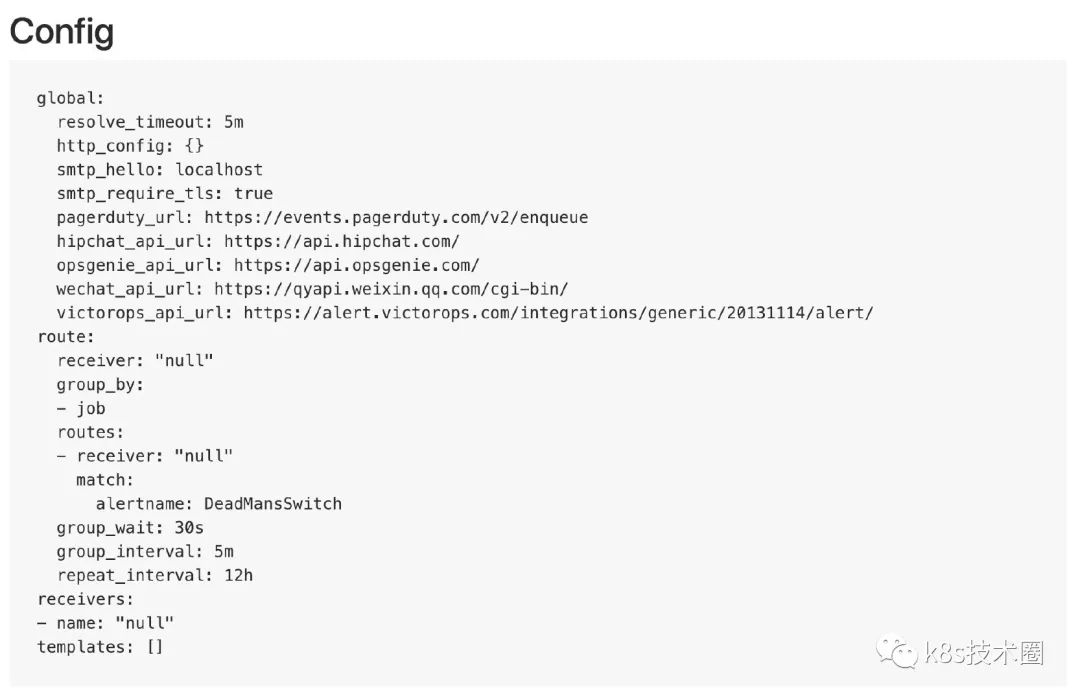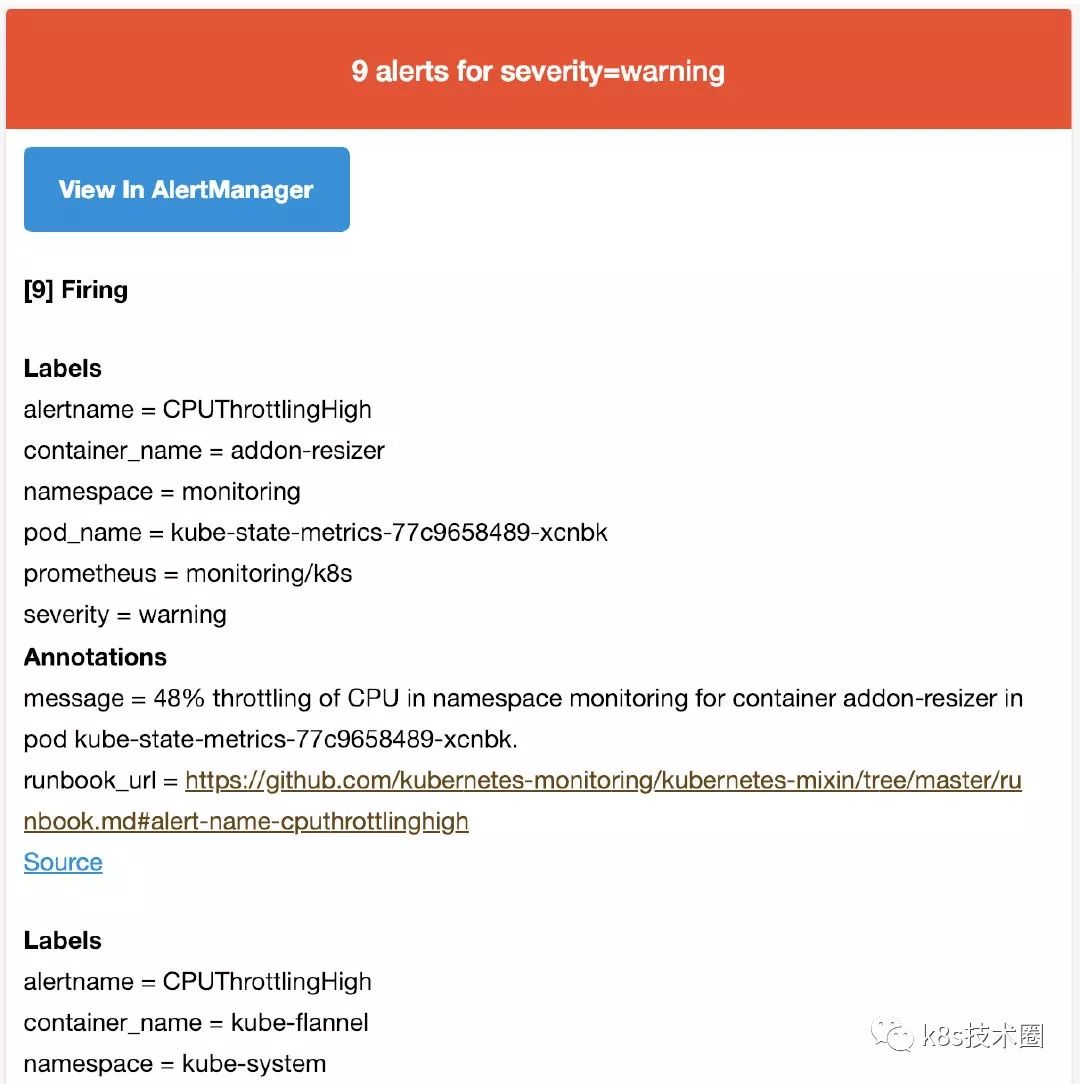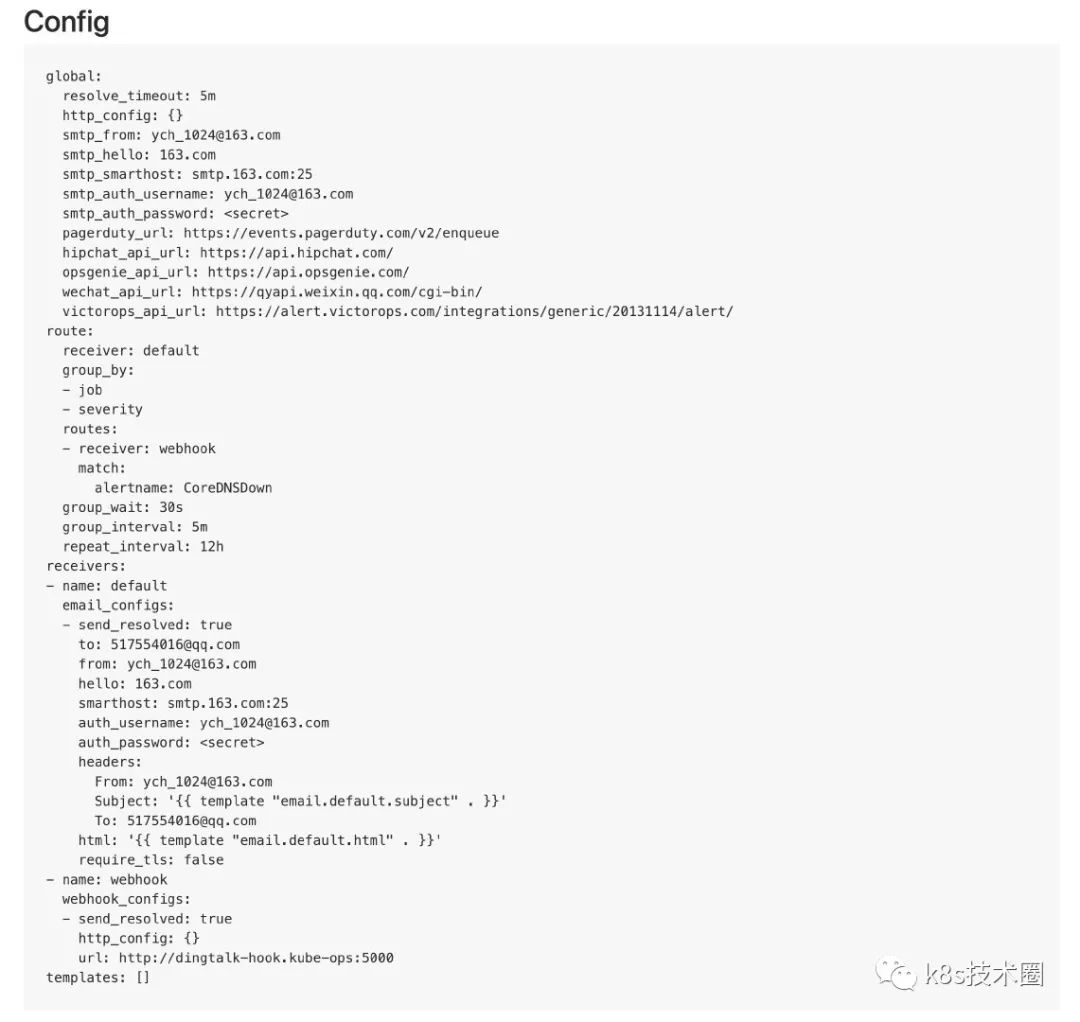Prometheus Operator 自定义报警
作者 阳明
来源 | k8s技术圈(ID:kube100)
配置 PrometheusRule
现在我们知道怎么自定义一个 ServiceMonitor 对象了,但是如果需要自定义一个报警规则的话呢?比如现在我们去查看 Prometheus Dashboard 的 Alert 页面下面就已经有一些报警规则了,还有一些是已经触发规则的了:

但是这些报警信息是哪里来的呢?他们应该用怎样的方式通知我们呢?我们知道之前我们使用自定义的方式可以在 Prometheus 的配置文件之中指定 AlertManager 实例和 报警的 rules 文件,现在我们通过 Operator 部署的呢?我们可以在 Prometheus Dashboard 的 Config 页面下面查看关于 AlertManager 的配置:
alerting:
alert_relabel_configs:
- separator: ;
regex: prometheus_replica
replacement: $1
action: labeldrop
alertmanagers:
- kubernetes_sd_configs:
- role: endpoints
namespaces:
names:
- monitoring
scheme: http
path_prefix: /
timeout: 10s
relabel_configs:
- source_labels: [__meta_kubernetes_service_name]
separator: ;
regex: alertmanager-main
replacement: $1
action: keep
- source_labels: [__meta_kubernetes_endpoint_port_name]
separator: ;
regex: web
replacement: $1
action: keep
rule_files:
- /etc/prometheus/rules/prometheus-k8s-rulefiles-0/*.yaml
上面 alertmanagers 实例的配置我们可以看到是通过角色为 endpoints 的 kubernetes 的服务发现机制获取的,匹配的是服务名为 alertmanager-main,端口名未 web 的 Service 服务,我们查看下 alertmanager-main 这个 Service:
kubectl describe svc alertmanager-main -n monitoring
Name: alertmanager-main
Namespace: monitoring
Labels: alertmanager=main
Annotations: kubectl.kubernetes.io/last-applied-configuration={"apiVersion":"v1","kind":"Service","metadata":{"annotations":{},"labels":{"alertmanager":"main"},"name":"alertmanager-main","namespace":"monitoring"},...
Selector: alertmanager=main,app=alertmanager
Type: NodePort
IP: 10.104.156.29
Port: web 9093/TCP
TargetPort: web/TCP
NodePort: web 31918/TCP
Endpoints: 10.244.2.34:9093,10.244.2.37:9093,10.244.4.109:9093
Session Affinity: None
External Traffic Policy: Cluster
Events: <none>
可以看到服务名正是 alertmanager-main,Port 定义的名称也是 web,符合上面的规则,所以 Prometheus 和 AlertManager 组件就正确关联上了。而对应的报警规则文件位于: /etc/prometheus/rules/prometheus-k8s-rulefiles-0/目录下面所有的 YAML 文件。我们可以进入 Prometheus 的 Pod 中验证下该目录下面是否有 YAML 文件:
$ kubectl exec -it prometheus-k8s-0 /bin/sh -n monitoring
Defaulting container name to prometheus.
Use 'kubectl describe pod/prometheus-k8s-0 -n monitoring' to see all of the containers in this pod.
/prometheus $ ls /etc/prometheus/rules/prometheus-k8s-rulefiles-0/
monitoring-prometheus-k8s-rules.yaml
/prometheus $ cat /etc/prometheus/rules/prometheus-k8s-rulefiles-0/monitoring-pr
ometheus-k8s-rules.yaml
groups:
- name: k8s.rules
rules:
- expr: |
sum(rate(container_cpu_usage_seconds_total{job="kubelet", image!="", container_name!=""}[5m])) by (namespace)
record: namespace:container_cpu_usage_seconds_total:sum_rate
......
这个 YAML 文件实际上就是我们之前创建的一个 PrometheusRule 文件包含的:
$ cat prometheus-rules.yaml
apiVersion: monitoring.coreos.com/v1
kind: PrometheusRule
metadata:
labels:
prometheus: k8s
role: alert-rules
name: prometheus-k8s-rules
namespace: monitoring
spec:
groups:
- name: k8s.rules
rules:
- expr: |
sum(rate(container_cpu_usage_seconds_total{job="kubelet", image!="", container_name!=""}[5m])) by (namespace)
record: namespace:container_cpu_usage_seconds_total:sum_rate
我们这里的 PrometheusRule 的 name 为 prometheus-k8s-rules,namespace 为 monitoring,我们可以猜想到我们创建一个 PrometheusRule 资源对象后,会自动在上面的 prometheus-k8s-rulefiles-0 目录下面生成一个对应的 <namespace>-<name>.yaml文件,所以如果以后我们需要自定义一个报警选项的话,只需要定义一个 PrometheusRule 资源对象即可。至于为什么 Prometheus 能够识别这个 PrometheusRule 资源对象呢?这就需要查看我们创建的 prometheus 这个资源对象了,里面有非常重要的一个属性 ruleSelector,用来匹配 rule 规则的过滤器,要求匹配具有 prometheus=k8s 和 role=alert-rules 标签的 PrometheusRule 资源对象,现在明白了吧?
ruleSelector:
matchLabels:
prometheus: k8s
role: alert-rules
所以我们要想自定义一个报警规则,只需要创建一个具有 prometheus=k8s 和 role=alert-rules 标签的 PrometheusRule 对象就行了,比如现在我们添加一个 etcd 是否可用的报警,我们知道 etcd 整个集群有一半以上的节点可用的话集群就是可用的,所以我们判断如果不可用的 etcd 数量超过了一半那么就触发报警,创建文件
prometheus-etcdRules.yaml:
apiVersion: monitoring.coreos.com/v1
kind: PrometheusRule
metadata:
labels:
prometheus: k8s
role: alert-rules
name: etcd-rules
namespace: monitoring
spec:
groups:
- name: etcd
rules:
- alert: EtcdClusterUnavailable
annotations:
summary: etcd cluster small
description: If one more etcd peer goes down the cluster will be unavailable
expr: |
count(up{job="etcd"} == 0) > (count(up{job="etcd"}) / 2 - 1)
for: 3m
labels:
severity: critical注意 label 标签一定至少要有 prometheus=k8s 和 role=alert-rules,创建完成后,隔一会儿再去容器中查看下 rules 文件夹:
kubectl exec -it prometheus-k8s-0 /bin/sh -n monitoring
Defaulting container name to prometheus.
Use 'kubectl describe pod/prometheus-k8s-0 -n monitoring' to see all of the containers in this pod.
/prometheus $ ls /etc/prometheus/rules/prometheus-k8s-rulefiles-0/
monitoring-etcd-rules.yaml monitoring-prometheus-k8s-rules.yaml
可以看到我们创建的 rule 文件已经被注入到了对应的 rulefiles 文件夹下面了,证明我们上面的设想是正确的。然后再去 Prometheus Dashboard 的 Alert 页面下面就可以查看到上面我们新建的报警规则了:

配置报警
我们知道了如何去添加一个报警规则配置项,但是这些报警信息用怎样的方式去发送呢?前面的课程中我们知道我们可以通过 AlertManager 的配置文件去配置各种报警接收器,现在我们是通过 Operator 提供的 alertmanager 资源对象创建的组件,应该怎样去修改配置呢?
首先我们将 alertmanager-main 这个 Service 改为 NodePort 类型的 Service,修改完成后我们可以在页面上的 status 路径下面查看 AlertManager 的配置信息:

这些配置信息实际上是来自于我们之前在 prometheus-operator/contrib/kube-prometheus/manifests目录下面创建的 alertmanager-secret.yaml 文件:
apiVersion: v1
data:
alertmanager.yaml: Imdsb2JhbCI6IAogICJyZXNvbHZlX3RpbWVvdXQiOiAiNW0iCiJyZWNlaXZlcnMiOiAKLSAibmFtZSI6ICJudWxsIgoicm91dGUiOiAKICAiZ3JvdXBfYnkiOiAKICAtICJqb2IiCiAgImdyb3VwX2ludGVydmFsIjogIjVtIgogICJncm91cF93YWl0IjogIjMwcyIKICAicmVjZWl2ZXIiOiAibnVsbCIKICAicmVwZWF0X2ludGVydmFsIjogIjEyaCIKICAicm91dGVzIjogCiAgLSAibWF0Y2giOiAKICAgICAgImFsZXJ0bmFtZSI6ICJEZWFkTWFuc1N3aXRjaCIKICAgICJyZWNlaXZlciI6ICJudWxsIg==
kind: Secret
metadata:
name: alertmanager-main
namespace: monitoring
type: Opaque
可以将 alertmanager.yaml 对应的 value 值做一个 base64 解码:
$ echo "Imdsb2JhbCI6IAogICJyZXNvbHZlX3RpbWVvdXQiOiAiNW0iCiJyZWNlaXZlcnMiOiAKLSAibmFtZSI6ICJudWxsIgoicm91dGUiOiAKICAiZ3JvdXBfYnkiOiAKICAtICJqb2IiCiAgImdyb3VwX2ludGVydmFsIjogIjVtIgogICJncm91cF93YWl0IjogIjMwcyIKICAicmVjZWl2ZXIiOiAibnVsbCIKICAicmVwZWF0X2ludGVydmFsIjogIjEyaCIKICAicm91dGVzIjogCiAgLSAibWF0Y2giOiAKICAgICAgImFsZXJ0bmFtZSI6ICJEZWFkTWFuc1N3aXRjaCIKICAgICJyZWNlaXZlciI6ICJudWxsIg==" | base64 -d
"global":
"resolve_timeout": "5m"
"receivers":
- "name": "null"
"route":
"group_by":
- "job"
"group_interval": "5m"
"group_wait": "30s"
"receiver": "null"
"repeat_interval": "12h"
"routes":
- "match":
"alertname": "DeadMansSwitch"
"receiver": "null"我们可以看到内容和上面查看的配置信息是一致的,所以如果我们想要添加自己的接收器,或者模板消息,我们就可以更改这个文件:
global:
resolve_timeout: 5m
smtp_smarthost: 'smtp.163.com:25'
smtp_from: 'ych_1024@163.com'
smtp_auth_username: 'ych_1024@163.com'
smtp_auth_password: '<邮箱密码>'
smtp_hello: '163.com'
smtp_require_tls: false
route:
group_by: ['job', 'severity']
group_wait: 30s
group_interval: 5m
repeat_interval: 12h
receiver: default
routes:
- receiver: webhook
match:
alertname: CoreDNSDown
receivers:
- name: 'default'
email_configs:
- to: '517554016@qq.com'
send_resolved: true
- name: 'webhook'
webhook_configs:
- url: 'http://dingtalk-hook.kube-ops:5000'
send_resolved: true
将上面文件保存为 alertmanager.yaml,然后使用这个文件创建一个 Secret 对象:
# 先将之前的 secret 对象删除
$ kubectl delete secret alertmanager-main -n monitoring
secret "alertmanager-main" deleted
$ kubectl create secret generic alertmanager-main --from-file=alertmanager.yaml -n monitoring
secret "alertmanager-main" created
我们添加了两个接收器,默认的通过邮箱进行发送,对于 CoreDNSDown 这个报警我们通过 webhook 来进行发送,这个 webhook 就是我们前面课程中定义的一个钉钉接收的 Server,上面的步骤创建完成后,很快我们就会收到一条钉钉消息:

同样邮箱中也会收到报警信息:

我们再次查看 AlertManager 页面的 status 页面的配置信息可以看到已经变成上面我们的配置信息了:

AlertManager 配置也可以使用模板(.tmpl文件),这些模板可以与 alertmanager.yaml 配置文件一起添加到 Secret 对象中,比如:
apiVersion:v1
kind:secret
metadata:
name:alertmanager-example
data:
alertmanager.yaml:{BASE64_CONFIG}
template_1.tmpl:{BASE64_TEMPLATE_1}
template_2.tmpl:{BASE64_TEMPLATE_2}
...
模板会被放置到与配置文件相同的路径,当然要使用这些模板文件,还需要在 alertmanager.yaml 配置文件中指定:
templates:
- '*.tmpl'
创建成功后,Secret 对象将会挂载到 AlertManager 对象创建的 AlertManager Pod 中去。




















